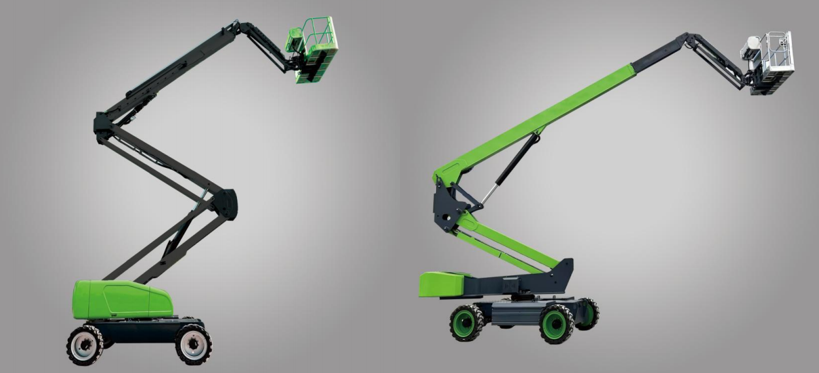Selecting the right aerial work platform is a challenge for many project managers. Choosing between electric and diesel models not only affects operational efficiency but also directly impacts operating costs and overall safety. This guide will help you clarify your needs and identify the best solution for your project.
Fundamental Differences in Power Sources
The first step is to understand the core distinction between the two.
Electric aerial work platforms are powered by battery packs and rely on motors for lifting and movement. They are zero-emission and low-noise—true “quiet champions.” Diesel platforms, by contrast, run on diesel engines that deliver strong power but produce exhaust fumes and considerable noise, making them the “powerful contenders.” In simple terms, the difference is similar to that between new energy vehicles and traditional gasoline cars, and this fundamental distinction ultimately determines their ideal application scenarios.
Five-Dimension Comparison
1. Environmental Protection & Noise Control:
Electric platforms offer absolute advantages: zero emissions and low noise, making them the preferred choice in environments with strict environmental standards. Diesel platforms, due to noise and exhaust emissions, are generally limited to outdoor applications.
2. Operating Environment Adaptability:
Electric platforms are designed for indoor areas and locations requiring higher environmental protection. Diesel platforms are better suited for outdoor construction sites and open, well-ventilated environments.
3. Power & Performance Characteristics:
Electric platforms operate smoothly but have relatively limited climbing capability.
Diesel platforms provide strong power and excel in off-road and steep-terrain conditions.
4. Operating Cost:
Electric platforms feature lower electricity costs, simpler maintenance, and reduced long-term costs. Diesel platforms incur higher fuel expenses, require more complex maintenance, and lead to higher lifetime operating costs.
5. Range & Endurance:
Electric platforms require charging and are restricted by battery capacity. Diesel platforms can be refueled quickly, offer excellent endurance, and are ideal for high-intensity, continuous operations.
Choosing Based on Operating Environment
Selecting the right platform begins with understanding the work environment.
Indoor, enclosed spaces—such as shopping malls, office buildings, and factory renovation/maintenance—benefit from the zero-emission performance of electric platforms.
Noise-sensitive locations—including hospitals, schools, and residential communities—require the quiet operation of electric models.
Cleanliness-critical environments—such as electronics factories and clean- rooms—also rely heavily on electric platforms to prevent oil contamination.
Diesel platforms demonstrate their strengths on large outdoor construction sites. In scenarios such as exterior wall installation, bridge construction, and port operations, power and endurance outweigh environmental considerations. Diesel lift platforms also handle complex and rugged terrain with ease, thanks to their strong off-road capabilities. For projects requiring long-term, high-intensity operations, quick refueling significantly boosts productivity.
Hybrid Platforms: The Middle Ground
Hybrid aerial work platforms offer a balanced solution for users who frequently switch between indoor and outdoor environments. With three operating modes—pure electric, pure diesel, and hybrid—they combine environmental friendliness with excellent endurance. As a result, they are becoming an increasingly popular choice.
Three-Step Decision Method: Identify Your Needs Quickly
When making a choice, these three key questions can help you narrow down your options:
Clarify the work environment:
“Where will the platform be used?” Electric for indoor, diesel for outdoor, hybrid for both.
Evaluate economic factors:
“What is my budget, and what are my long-term plans?”
Electric fits users focused on long-term cost savings and who have access to charging facilities.
Diesel suits projects with limited upfront budgets but high-intensity workloads.
Confirm performance requirements:
“What specific performance features do I need?” For narrow aisles and heavy lifting: choose a heavy-duty electric scissor lift. For rough terrains and obstacle crossing: choose a high-power diesel articulated boom lift.
Under global “dual-carbon” goals, electrification is undeniably a major trend, and its technology is evolving rapidly. However, in the field of heavy-duty outdoor operations, diesel platforms still hold an irreplaceable role. There is no absolute right or wrong choice—the key is selecting the platform that best matches your specific needs.
By understanding these core differences and application scenarios, you can confidently choose the most reliable aerial work platform for your project.
Post time: Nov-22-2025


